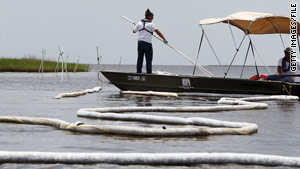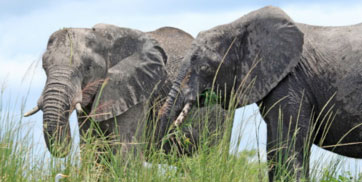TOP STORIES Sewage spill kills thousands of fish
A weekend sewage leak killed thousands of fish and other wildlife in the Stones River West Fork and may lead to the state fining the city of Murfreesboro, an official said.
. . . Kirchner said a lightning strike around 3 or 4 p.m. Saturday caused the pump station failure and probably contributed to sensors failing to recognize something was wrong.
A resident called sewer system staff the next day to alert the department after noticing dead fish and gray water near the bridge.
The Tennessean - www.tennessean.com
S Broden
04 Aug 2010
Photo credit: J Gillis/DNJ
Location: Murfreesboro, Tennessee, USA - Map It
S Broden
04 Aug 2010
Photo credit: J Gillis/DNJ
Location: Murfreesboro, Tennessee, USA - Map It

Botulism, avian - Spain: (CM), water birds, susp., RFI
Operatives of the Agriculture and Environment (Ministry) of Castilla-La Mancha have collected specimens of dead birds in Lake Navaseca, located a few kilometers from the National Park of Las Tablas de Daimiel (Ciudad Real).
Lake Navaseca collects treated water from the Daimiel Wastewater station and has become in recent years, in the absence of water in the National Park of Las Tablas de Navaseca, an alternative habitat for birds.
According to various sources consulted by Efe (The Spanish National News Agency), the death of these birds could have been caused by an outbreak of avian botulism by ingestion of a toxin produced by the bacterium _Clostridium botulinum_. That is a form of food poisoning
that causes birds to develop a neural paralysis which inhibits the body's muscular response.
ProMED Mail - www.promedmail.org [Source ADN - www.adn.es and EFE - www.efe.com]
02 Aug 2010
Location: Laguna Navaseca, Castilla-La Mancha, Spain - Map It
02 Aug 2010
Location: Laguna Navaseca, Castilla-La Mancha, Spain - Map It

 California Sea Otter numbers drop again
California Sea Otter numbers drop againAfter a decade of steady recovery, the southern sea otter — a federally listed threatened species — is in decline for the second year in a row, according to the latest population survey by U.S. Geological Survey researchers.
. . . Population estimates are calculated as three-year averages of annual survey results, which compensate for variability in observation conditions and give scientists a more reliable picture of abundance trends. This year’s estimate — averaging counts from 2010, 2009 and 2008 — is 2,711 otters. This represents a 3.6 percent drop for the overall population and an 11 percent drop in the number of otter pups, compared to 2009 estimates.
. . . “Our data suggest that breeding-age females are dying in higher than usual numbers from multiple causes, including infectious disease, toxin-exposure, heart failure, malnutrition and shark attacks,” Tinker says.
USGS Newsroom - www.usgs.gov/newsroom
03 Aug 2010
Photo credit: T Larson/U.S. Geological Survey
03 Aug 2010
Photo credit: T Larson/U.S. Geological Survey
 Census of marine life released
Census of marine life releasedA ten-year inventory of the world's sea creatures has revealed an astonishing level of diversity and a growing number of species, with no end in sight.
The latest collection of papers relating to the Census of Marine Life (CoML), posted on PloS ONE, contains the most comprehensive record of marine biodiversity ever, says senior project scientist Ron O'Dor, based at Dalhousie University in Halifax, Nova Scotia, Canada1.
The census has focused on the participating countries' 'exclusive economic zones', which stretch 200 nautical miles (370 kilometres) out from the coastline.
M Gaskill/Nature News - www.nature.com
03 Aug 2010
Photo credit: H. Bahena
03 Aug 2010
Photo credit: H. Bahena
Cited Journal Articles
>>> Marine Biodiversity and Biogeography – Regional Comparisons of Global Issues, an Introduction. PLoS One. 5(8): e11871. (2010).
>>> A Census of Marine Biodiversity Knowledge, Resources, and Future Challenges. PLoS One. 5(8): e12110. (2010).
>>> A Census of Marine Biodiversity Knowledge, Resources, and Future Challenges. PLoS One. 5(8): e12110. (2010).
Related News
>>> Record-Breaking Sea-Creature Surveys Released [video]
>>> Sea-Creature Discoveries Spawn Music Video [video]
>>> Sea-Creature Discoveries Spawn Music Video [video]
 EPA: Dispersant-oil mix no more toxic than oil alone
EPA: Dispersant-oil mix no more toxic than oil aloneTesting has found that eight dispersants, including one used in combating the Gulf of Mexico oil disaster, are no more toxic when mixed with oil than the oil alone, the Environmental Protection Agency said Monday.
The tests prove that the oil itself, not the dispersants, is "enemy No. 1," Paul Anastas, EPA assistant administrator for research and development, told reporters on a conference call.
. . . Testing was done on sensitive marine species in their juvenile life stage, when they are at their most sensitive, Anastas said.
CNN - www.cnn.com
02 Aug 2010
Photo courtesy of CNN
02 Aug 2010
Photo courtesy of CNN
Related News
>>> Despite Reports of Contaminated Wildlife, States Reopening Waters to Fishing
>>> Grant will help turtles [Gulf Coast, USA]
>>> BP oil spill update: map of Gulf of Mexico 8-4-2010 - static kill status and wildlife update [includes map and collection report]
>>> Grant will help turtles [Gulf Coast, USA]
>>> BP oil spill update: map of Gulf of Mexico 8-4-2010 - static kill status and wildlife update [includes map and collection report]
OTHER WILDLIFE HEALTH RELATED NEWS
Photo courtesy of Mongabay.com
 National Ban on Lead-based Ammunition, Fishing Tackle Sought to End Wildlife Poisoning
National Ban on Lead-based Ammunition, Fishing Tackle Sought to End Wildlife Poisoning- F&G: Wolves not causing most elk losses
- Scientists unravel human-ecosystem interactions
- Testing fish for viral & bacteria pathogens [includes video; Wisconsin, USA]
- New Chief for USGS National Climate Change and Wildlife Science Center
- Is Africa's wildlife being eaten to extinction?
- Trade in endangered reptiles is rampant in Indonesia, wildlife monitoring network says
- Endangered Animals: 10 Reasons for Hope
- White-nose syndrome killing bats in droves
- BLM weighs decision on closing caves
- LBL and APSU monitoring local bat population [Kentucky and Tennessee, USA]
- Bat Fungus Nixes Mo. Park Wild Cave Tours




